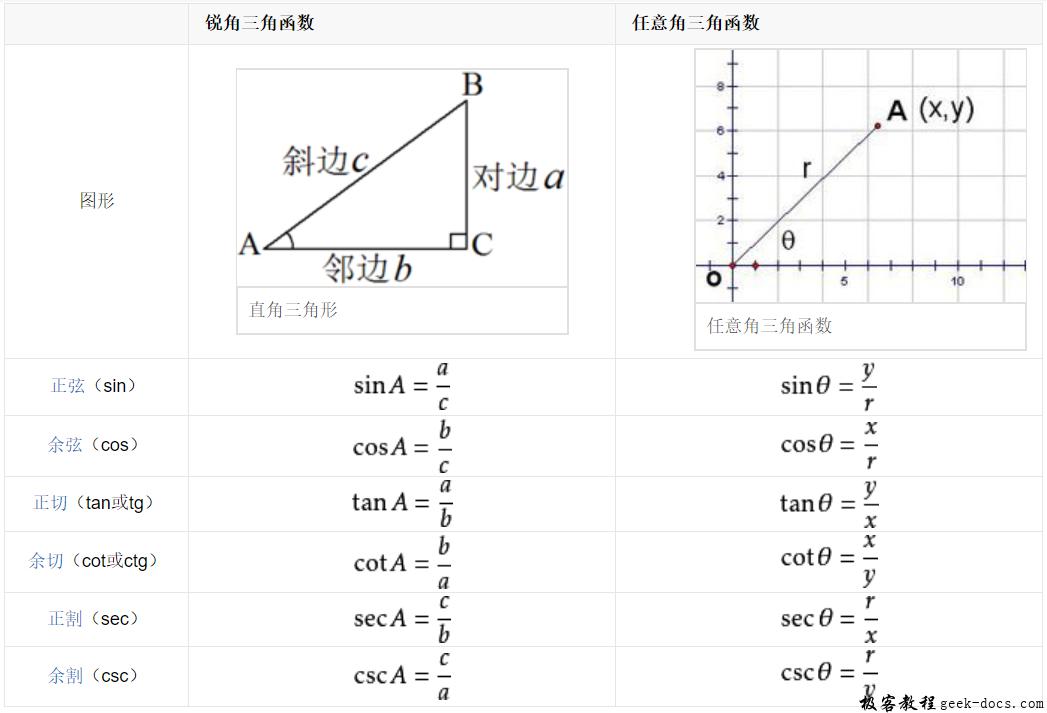NumPy 数学函数,NumPy 包含大量的数学运算的函数,包括三角函数,算术运算的函数,复数处理函数等。
三角函数
NumPy 提供了标准的三角函数:sin()、cos()、tan()等

import numpy as np
a = np.array([0, 30, 45, 60, 90])
print('不同角度的正弦值:')
# 通过乘 pi/180 转化为弧度
print(np.sin(a * np.pi / 180))
print('数组中角度的余弦值:')
print(np.cos(a * np.pi / 180))
print('数组中角度的正切值:')
print(np.tan(a * np.pi / 180))
输出结果为:
不同角度的正弦值:
[0. 0.5 0.70710678 0.8660254 1. ]
数组中角度的余弦值:
[1.00000000e+00 8.66025404e-01 7.07106781e-01 5.00000000e-01
6.12323400e-17]
数组中角度的正切值:
[0.00000000e+00 5.77350269e-01 1.00000000e+00 1.73205081e+00
1.63312394e+16]
arcsin,arccos,和 arctan 函数返回给定角度的 sin,cos 和 tan 的反三角函数。
这些函数的结果可以通过 numpy.degrees() 函数将弧度转换为角度。
import numpy as np
a = np.array([0,30,45,60,90])
print ('含有正弦值的数组:')
sin = np.sin(a*np.pi/180)
print (sin)
print ('计算角度的反正弦,返回值以弧度为单位:')
inv = np.arcsin(sin)
print (inv)
print ('通过转化为角度制来检查结果:')
print (np.degrees(inv))
print ('arccos 和 arctan 函数行为类似:')
cos = np.cos(a*np.pi/180)
print (cos)
print ('反余弦:')
inv = np.arccos(cos)
print (inv)
print ('角度制单位:')
print (np.degrees(inv))
print ('tan 函数:')
tan = np.tan(a*np.pi/180)
print (tan)
print ('反正切:')
inv = np.arctan(tan)
print (inv)
print ('角度制单位:')
print (np.degrees(inv))
输出结果为:
含有正弦值的数组:
[0. 0.5 0.70710678 0.8660254 1. ]
计算角度的反正弦,返回值以弧度为单位:
[0. 0.52359878 0.78539816 1.04719755 1.57079633]
通过转化为角度制来检查结果:
[ 0. 30. 45. 60. 90.]
arccos 和 arctan 函数行为类似:
[1.00000000e+00 8.66025404e-01 7.07106781e-01 5.00000000e-01
6.12323400e-17]
反余弦:
[0. 0.52359878 0.78539816 1.04719755 1.57079633]
角度制单位:
[ 0. 30. 45. 60. 90.]
tan 函数:
[0.00000000e+00 5.77350269e-01 1.00000000e+00 1.73205081e+00
1.63312394e+16]
反正切:
[0. 0.52359878 0.78539816 1.04719755 1.57079633]
角度制单位:
[ 0. 30. 45. 60. 90.]
numpy.around()
numpy.around() 函数返回指定数字的四舍五入值。
numpy.around(a,decimals)
| 参数 | 说明 |
|---|---|
| a | 数组 |
| decimals | 舍入的小数位数。 默认值为0。 如果为负,整数将四舍五入到小数点左侧的位置 |
import numpy as np
a = np.array([1.0,5.55, 123, 0.567, 25.532])
print ('原数组:')
print (a)
print ('舍入后:')
print (np.around(a))
print (np.around(a, decimals = 1))
print (np.around(a, decimals = -1))
输出结果为:
原数组:
[ 1. 5.55 123. 0.567 25.532]
舍入后:
[ 1. 6. 123. 1. 26.]
[ 1. 5.6 123. 0.6 25.5]
[ 0. 10. 120. 0. 30.]
numpy.floor()
numpy.floor() 返回数字的下舍整数。
import numpy as np
a = np.array([-1.7, 1.5, -0.2, 0.6, 10])
print ('提供的数组:')
print (a)
print ('修改后的数组:')
print (np.floor(a))
输出结果为:
提供的数组:
[-1.7 1.5 -0.2 0.6 10. ]
修改后的数组:
[-2. 1. -1. 0. 10.]
numpy.ceil()
numpy.ceil() 返回数字的上入整数。
import numpy as np
a = np.array([-1.7, 1.5, -0.2, 0.6, 10])
print ('提供的数组:')
print (a)
print ('修改后的数组:')
print (np.ceil(a))
输出结果为:
提供的数组:
[-1.7 1.5 -0.2 0.6 10. ]
修改后的数组:
[-1. 2. -0. 1. 10.]
 极客教程
极客教程